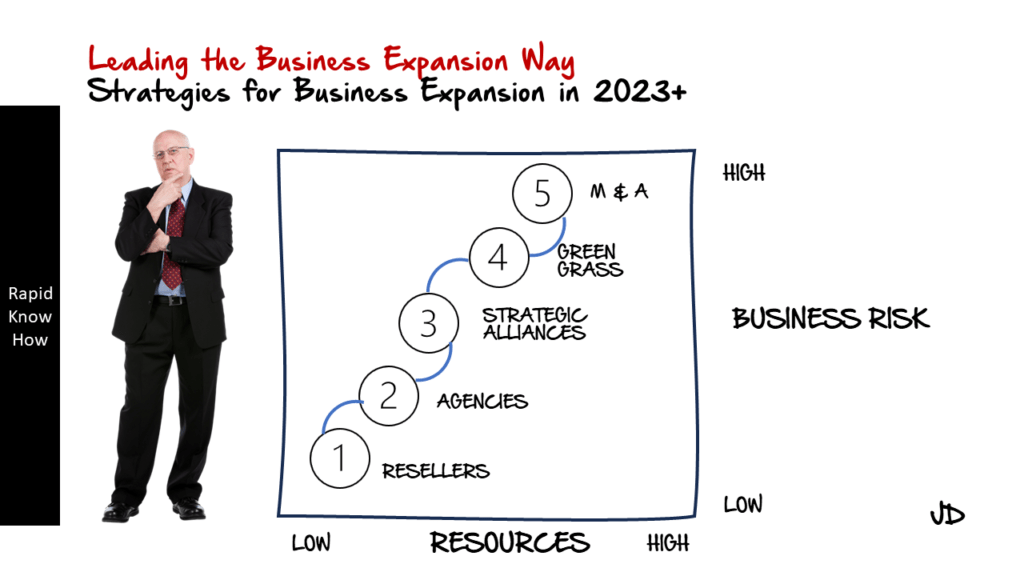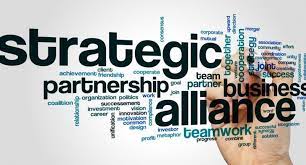Geographical expansion refers to the process of a business extending its operations or presence into new regions or countries. This can be achieved through various means such as Green Grass Expansion; Reseller and Agency models; Mergers and Acqusitions; Forming Strategic Alliances and Licensing Strategic Know-How.
can lead the way towards sustainable growth with the GREEN GRASS Expansion model!
THE RESELLER and AGENCY EXPANSION MODEL
Leading the way in strategic alliances is a critical aspect of business growth and development. It involves creating partnerships with other organizations to achieve common goals. Two key types of strategic alliances are resellers and agency alliances.
Resellers are businesses that purchase products or services from a manufacturer or service provider and then sell them to their customers. They act as intermediaries between the manufacturer and the end-user, providing a valuable distribution channel for the manufacturer’s products or services.
Agency alliances, on the other hand, are partnerships between companies where one company acts as an agent for another. This could involve selling the other company’s products or services, or it could involve providing some form of support or service on behalf of the other company.
Applying resellers and agency alliances can be beneficial for several reasons.
Firstly, they can help to extend your reach into new markets or customer segments that you may not have been able to access on your own.
Secondly, they can provide additional resources and capabilities that can enhance your own product or service offering.
Finally, they can help to spread risk and reduce costs by sharing resources and responsibilities.
When to apply Reseller and Agency Alliances Models?
Resellers and agency alliances can be applied in various contexts. They are particularly useful in industries where products or services need to be distributed widely or where there is a need for local knowledge or expertise. This could include industries such as technology, manufacturing, retail, and professional services.
The timing of when to apply resellers and agency alliances will depend on your specific business needs and circumstances. However, some potential triggers could include when you are looking to enter a new market, when you want to launch a new product or service, or when you need additional resources or capabilities.
How to Apply Reseller and Agency Alliances ?
Applying reseller and agency alliances involves several steps.
Firstly, you need to identify potential partners who have the necessary resources, capabilities, and market access.
Secondly, you need to negotiate an agreement that outlines the terms of the partnership, including roles and responsibilities, financial arrangements, and dispute resolution procedures.
Finally, you need to manage the alliance effectively to ensure that it delivers the expected benefits.
Case Studies
There are numerous case studies that illustrate the benefits of reseller and agency alliances. For example, Microsoft has a vast network of resellers who sell its software products to businesses around the world. Similarly, many advertising agencies form alliances with media companies to provide integrated marketing solutions for their clients.
In conclusion, leading the way in strategic alliances through resellers and agency alliances can provide significant benefits for businesses. However, it requires careful planning, negotiation, and management to ensure success.
As a call-to-action step-by-step guide:
1) Identify potential partners.
2) Negotiate an agreement.
3) Manage the alliance effectively.
4) Review regularly for continuous improvement.
5) Celebrate successes together.
By following these steps carefully while keeping an open mind for adjustments along the way based on real-time feedback from your partners and customers alike will ensure successful implementation of reseller and agency alliances in your business strategy.
THE GREEN GRASS EXPANSION MODEL
GREEN GRASS Expansion is a strategic business model that focuses on the growth and expansion of a company or organization in an environmentally friendly and sustainable manner. The term “GREEN” signifies the commitment to environmental sustainability, while “GRASS” is an acronym for Growth, Responsibility, Adaptability, Sustainability, and Scalability. This model encourages businesses to grow and expand while taking responsibility for their environmental impact, adapting to changes in the business environment, maintaining sustainability in their operations, and ensuring scalability of their business processes.

**Why Apply GREEN GRASS Expansion?**
Applying the GREEN GRASS Expansion model is crucial for several reasons.
Firstly, it aligns your business with global efforts towards environmental sustainability. This not only enhances your corporate image but also opens up opportunities for partnerships with other environmentally conscious entities.
Secondly, it ensures that your business remains adaptable to changes in the business environment, which is crucial for survival in today’s dynamic market. Thirdly, it promotes sustainability and scalability of your operations, ensuring long-term success.
**Where to Apply GREEN GRASS Expansion?**
The GREEN GRASS Expansion model can be applied across all sectors and industries. Whether you’re running a manufacturing company, a tech startup, or a service-oriented business, this model can be integrated into your strategic planning process. It’s particularly beneficial for businesses operating in industries with high environmental impact such as energy production, manufacturing, agriculture, and transportation.
**When to Apply GREEN GRASS Expansion?**
The best time to apply the GREEN GRASS Expansion model is during the strategic planning phase of your business. However, it’s never too late to incorporate this model into your operations. Whether you’re just starting out or looking to scale up your operations, applying this model can help you achieve sustainable growth.
**How to Apply GREEN GRASS Expansion?**
Applying the GREEN GRASS Expansion model involves several steps:
1. **Growth**: Develop a growth strategy that aligns with your commitment to environmental sustainability.
2. **Responsibility**: Take responsibility for your environmental impact by implementing eco-friendly practices.
3. **Adaptability**: Stay adaptable by keeping abreast of changes in the business environment and adjusting your strategies accordingly.
4. **Sustainability**: Ensure sustainability of your operations by minimizing waste and maximizing resource efficiency.
5. **Scalability**: Plan for scalability by developing processes that can be easily expanded as your business grows.
**Case Studies**
Several companies have successfully applied the GREEN GRASS Expansion model:
– Patagonia: This outdoor clothing company has integrated environmental responsibility into its growth strategy by using recycled materials in its products and donating 1% of its sales to environmental causes.
– Tesla: The electric vehicle manufacturer has demonstrated adaptability by pioneering innovations in battery technology to overcome challenges in the automotive industry.
– IKEA: The furniture retailer has ensured sustainability of its operations by sourcing wood from sustainable sources and investing in renewable energy.
**Conclusion**
In conclusion, the GREEN GRASS Expansion model provides a roadmap for businesses seeking to achieve growth while maintaining their commitment to environmental sustainability. By applying this model, businesses can enhance their corporate image, stay adaptable in a dynamic market environment, ensure long-term success through sustainable practices, and plan for scalability.
**Call-to-Action Step-by-Step**
1. Evaluate your current business practices against the principles of the GREEN GRASS Expansion model.
2. Identify areas where you can improve or implement these principles.
3. Develop a strategic plan incorporating these principles into your growth strategy.
4. Implement eco-friendly practices across all areas of your operations.
5. Regularly review and adjust your strategies based on changes in the business environment.
6. Monitor and measure the impact of these changes on your business performance.
By following these steps, you can lead the way towards sustainable growth with the GREEN GRASS Expansion model!
The M & A EXPANSION MODEL
**What is M & A Expansion?**
Mergers and Acquisitions (M&A) expansion refers to the strategic growth strategy where a company expands its operations by acquiring or merging with other companies. This strategy is often employed to achieve rapid growth, diversify product offerings, enter new markets, or gain competitive advantages.
**Why Apply M & A Expansion?**
There are several reasons why a company might choose to apply M&A expansion.
Firstly, it can provide immediate access to new markets and customers, which would otherwise take years to build organically.
Secondly, it can bring in new technologies or expertise that the acquiring company lacks.
Thirdly, it can result in cost efficiencies through economies of scale.
Lastly, it can help a company diversify its risk by spreading its operations across different industries or geographical regions.
**Where to Apply M & A Expansion?**
M&A expansion can be applied in virtually any industry and any geographical location. However, it is particularly common in fast-growing industries like technology and healthcare where companies often need to acquire new technologies or expertise quickly to stay competitive. It’s also common in mature industries like utilities and manufacturing where companies are looking for ways to reduce costs and increase efficiency.
**When to Apply M & A Expansion?**
The timing of M&A expansion depends on several factors including the company’s strategic goals, market conditions, and financial health.
Generally speaking, companies might choose to pursue M&A when they have strong cash reserves and when market conditions are favorable (e.g., low interest rates). They might also choose to pursue M&A when they see strategic opportunities to acquire valuable assets at a good price.
**How to Apply M & A Expansion?**
Applying M&A expansion involves several steps:
1. Identify potential acquisition targets that align with your strategic goals.
2. Conduct thorough due diligence to assess the target’s financial health, business model, competitive position, etc.
3. Negotiate the terms of the deal including the purchase price and financing structure.
4. Obtain necessary approvals from regulators and shareholders.
5. Integrate the acquired company into your operations.
**Case Studies**
A classic example of successful M&A expansion is Google’s acquisition of YouTube in 2006. At that time, Google was primarily a search engine company with no presence in online video streaming. The acquisition allowed Google to quickly enter this fast-growing market and leverage its advertising technology to monetize YouTube’s user base.
Another example is Disney’s acquisition of Pixar in 2006 which allowed Disney to rejuvenate its animation studio with Pixar’s innovative technology and creative talent.
**Conclusion**
In conclusion, M&A expansion is a powerful growth strategy that can provide companies with immediate access to new markets, technologies, and customers. However, it also involves significant risks and challenges including integration issues, cultural clashes, and regulatory hurdles. Therefore, companies need to carefully plan their M&A strategy and conduct thorough due diligence before pursuing any deals.
**Call-to-Action Step-by-Step**
If you’re considering an M&A expansion strategy for your business:
1. Start by clearly defining your strategic goals.
2. Identify potential acquisition targets that align with these goals.
3. Conduct thorough due diligence on these targets.
4. Negotiate the terms of the deal. 5. Obtain necessary approvals.
6. Plan for post-acquisition integration.
Remember: Successful M&A requires careful planning and execution!
THE STRATEGIC ALLIANCES EXPANSION MODEL
Strategic Alliances are a crucial aspect of modern business strategy, offering a robust and effective way to expand capabilities, reach new markets, and achieve growth objectives. They represent a formal agreement between two or more parties to pursue a set of agreed-upon objectives while remaining independent organizations.
**Why Apply Strategic Alliances?**
Strategic alliances offer numerous benefits that make them an attractive option for many businesses.
Firstly, they allow companies to access new markets and customers that would otherwise be difficult or impossible to reach. This can be particularly beneficial for businesses looking to expand internationally.
Secondly, strategic alliances can provide access to new technologies or expertise that a company does not possess internally. This can help to accelerate innovation and improve competitiveness.
Thirdly, strategic alliances can help to spread risk. By working with another company, the financial and operational risks associated with a particular project or initiative can be shared.
**Where to Apply Strategic Alliances?**
Strategic alliances can be applied in virtually any industry or sector where there is potential for mutual benefit between companies. They are particularly common in industries such as technology, where rapid innovation and global scale are critical for success. However, they can also be found in sectors such as manufacturing, healthcare, retail, and many others.
**When to Apply Strategic Alliances?**
The timing of when to form a strategic alliance depends largely on the specific circumstances of each company. However, some common triggers include when a company is looking to enter a new market, when it needs access to specific technology or expertise, or when it is looking to reduce risk on a major project.
**How to Apply Strategic Alliances?**
Forming a strategic alliance involves several key steps:
1. Identify Potential Partners: The first step is identifying potential partners who have the resources, capabilities, or market access that your company needs.
2. Evaluate Fit: Once potential partners have been identified, it’s important to evaluate how well they fit with your company’s culture, strategy, and objectives.
3. Negotiate Agreement: If a suitable partner is found, the next step is negotiating the terms of the alliance agreement. This will typically involve discussions around resource sharing, responsibilities, revenue sharing, and other key issues.
4. Implement Alliance: Once the agreement has been signed, the next step is implementing the alliance. This will typically involve integrating processes, systems, and teams as necessary.
5. Manage Alliance: Finally, it’s important to actively manage the alliance over time to ensure it continues to deliver value for both parties.
**Case Studies**
A classic example of successful strategic alliances is the partnership between Starbucks and Barnes & Noble. In this alliance, Starbucks provided coffee shops within Barnes & Noble stores – giving Starbucks access to book lovers and providing Barnes & Noble with an additional revenue stream.
Another example is the alliance between Spotify and Uber – where Uber riders could connect their Spotify accounts to control the music during their ride – enhancing customer experience for both companies’ users.
**Conclusion and Call-to-Action**
In conclusion, strategic alliances offer significant benefits for businesses looking to expand their reach, access new resources or reduce risk. However, they also require careful planning and management to ensure they deliver value over time.
If you’re considering forming a strategic alliance for your business – take time now to identify potential partners who align with your business goals and values; evaluate how well they fit with your company’s culture; negotiate an agreement that benefits both parties; implement the alliance effectively; and manage it actively over time.
Remember – successful strategic alliances are not just about signing an agreement – they’re about building long-term relationships that deliver ongoing value for both parties.

THE FRANCHISE EXPANSION MODEL
**What is FRANCHISE Expansion?**
Franchise expansion refers to the process of growing a business by granting third parties the right to operate under the brand’s name and system in different locations. This strategy allows businesses to expand their reach without the need for substantial capital investment. The franchisee pays an initial fee and ongoing royalties to the franchisor, and in return, they receive training, support, and the right to use the franchisor’s established brand name and business model.
**Why Apply FRANCHISE Expansion?**
There are several reasons why a business might choose to expand through franchising.
Firstly, it allows for rapid growth with less risk. The franchisee bears most of the financial risk, while the franchisor benefits from increased brand recognition and revenue from royalties.
Secondly, franchisees are often more motivated than employees because they have a direct stake in the business.
Lastly, franchising can be a cost-effective way of entering new markets, as local franchisees will have a better understanding of their area’s culture and consumer behavior.
**Where to Apply FRANCHISE Expansion?**
Franchise expansion can be applied in virtually any industry that has a successful and replicable business model. This includes sectors like food and beverage, retail, education, healthcare, beauty and wellness, real estate, and many more. It can also be applied in various locations – locally, nationally or internationally depending on the brand’s objectives and resources.
**When to Apply FRANCHISE Expansion?**
The best time to apply franchise expansion is when your business has a proven track record of success that can be replicated in different locations. Your business should have strong brand recognition, a loyal customer base, consistent profitability, effective systems in place for operations, training and support, and sufficient resources to support new franchisees.
**How to Apply FRANCHISE Expansion?**
Applying franchise expansion involves several steps:
1. Evaluate your readiness: Assess whether your business model is profitable and replicable.
2. Develop your franchise model: Determine your franchise fee structure, create operation manuals and training programs.
3. Legal considerations: Consult with a franchise attorney to develop your Franchise Disclosure Document (FDD) and Franchise Agreement.
4. Marketing your franchise: Use various channels like franchise expos, websites or brokers to attract potential franchisees.
5. Selecting your franchisees: Have a thorough selection process to ensure you choose the right partners.
6. Training & Support: Provide comprehensive training and ongoing support to help your franchisees succeed.
**Case Studies**
McDonald’s is one of the most successful examples of franchise expansion. They started franchising in 1955 with one restaurant in Illinois; today they have over 36,000 outlets worldwide with about 80% being owned by franchisees.
Another example is Anytime Fitness which started franchising in 2002; today they have over 4,000 gyms across 50 countries demonstrating how franchising can facilitate international expansion.
**Conclusion**
Franchise expansion is an effective strategy for businesses looking for rapid growth with less risk. It allows businesses to leverage the capital and local market knowledge of their franchisees while benefiting from increased brand recognition and revenue.
**Call-to-Action Step-by-Step**
1. Evaluate if your business is ready for franchising.
2. Consult with professionals (franchise consultants/lawyers) for guidance.
3. Develop your unique franchise model including fee structure & support system.
4. Market your opportunity effectively.
5. Choose your partners wisely – remember quality over quantity.
6. Provide ongoing support & training for success.
Remember that successful franchising requires careful planning & execution but when done right it can take your business to new heights!
THE LICENSING EXPANSION MODEL
Leading the LICENSING Expansion Way
Licensing expansion is a strategic business model that allows companies to expand their brand, products, or services into new markets or territories by granting other businesses the rights to use their intellectual property. This can include trademarks, patents, copyrights, or technology. It’s a powerful tool for growth and can be a win-win situation for both the licensor and licensee.
Why Apply LICENSING Expansion?
There are several reasons why a company might choose to apply licensing expansion.
Firstly, it allows for rapid market penetration without the need for substantial capital investment. The licensee bears most of the financial risk and responsibility for manufacturing, marketing, and distribution.
Secondly, it enables companies to tap into the established distribution networks and local market knowledge of their licensees. This can be particularly beneficial when expanding into foreign markets with different cultural norms and business practices.
Lastly, licensing can generate significant revenue through royalty payments. These are typically a percentage of sales and can provide a steady income stream with little ongoing effort or expense.
Where to Apply LICENSING Expansion?
Licensing expansion can be applied in virtually any industry where intellectual property is valuable. This includes sectors like technology, fashion, entertainment, food and beverage, pharmaceuticals, and more. It’s also applicable in both domestic and international markets.
When to Apply LICENSING Expansion?
The timing of licensing expansion depends on several factors. Companies need to have a strong brand or valuable intellectual property that others want to license. They also need to have reached a point in their growth where expansion makes strategic sense but may be constrained by capital or resources.
How to Apply LICENSING Expansion?
Applying licensing expansion involves several steps:
1. Identify potential licensees: Look for businesses that complement your own and have the resources and capabilities to successfully bring your product or service to market.
2. Negotiate terms: This includes royalty rates, minimum sales guarantees, territory rights, duration of agreement etc.
3. Monitor performance: Regularly review sales reports and conduct audits if necessary to ensure compliance with the agreement.
4. Protect your IP: Ensure your intellectual property rights are properly protected in all relevant jurisdictions.
Case Studies
A classic example of successful licensing expansion is Disney. They’ve licensed their beloved characters to countless manufacturers who produce everything from toys and clothing to home goods and electronics.
Another example is Microsoft’s licensing of its Windows operating system to PC manufacturers like Dell and HP. This allowed Microsoft to dominate the PC market without having to manufacture hardware themselves.
Conclusion
In conclusion, licensing expansion is an effective strategy for companies looking to grow without significant capital investment. It leverages the strengths of other businesses while generating revenue through royalties.
Call-to-Action Step-by-Step
If you’re considering licensing expansion:
1. Evaluate your brand or IP: Is it strong enough? Is it properly protected?
2. Research potential licensees: Who has the resources and capabilities you need?
3. Consult with an expert: Licensing agreements can be complex so it’s worth getting professional advice.
4. Negotiate terms: Don’t rush this process – make sure you get a deal that works for you.
5. Monitor performance: Keep an eye on how things are going – don’t just set it and forget it!
Remember – leading the licensing expansion way isn’t about taking the easy route; it’s about making strategic decisions that drive growth while mitigating risk.
The SOFTWARE AS A SERVICE (SaaS) EXPANSION MODEL
**What is SaaS Expansion?**
Software as a Service (SaaS) expansion refers to the process of growing and scaling a SaaS business by increasing its customer base, enhancing its product offerings, and expanding into new markets or regions. This can be achieved through various strategies such as upselling, cross-selling, customer retention, and acquisition of new customers.
**Why Apply SaaS Expansion?**
The application of SaaS expansion is crucial for several reasons.
Firstly, it allows businesses to maximize their revenue from existing customers. By offering additional services or products, businesses can increase their average revenue per user (ARPU).
Secondly, it helps in customer retention. By continuously improving and expanding their product offerings, businesses can ensure that their customers remain satisfied and continue to use their services.
Lastly, SaaS expansion allows businesses to tap into new markets and reach a larger audience.
**Where to Apply SaaS Expansion?**
SaaS expansion can be applied in various areas of a business. It can be applied in the product development department where new features or services are developed to cater to the evolving needs of customers.
It can also be applied in the sales and marketing departments where strategies are devised to upsell or cross-sell to existing customers and attract new ones.
Furthermore, it can be applied in the customer service department where efforts are made to improve customer satisfaction and retention rates.
**When to Apply SaaS Expansion?**
The timing for applying SaaS expansion depends on several factors such as the maturity of the business, market conditions, and customer demand. However, it is generally advisable for businesses to consider expansion once they have achieved product-market fit and have a stable customer base. This ensures that they have a solid foundation on which they can build and expand.
**How to Apply SaaS Expansion?**
Applying SaaS expansion involves several steps:
1. Identify Opportunities: The first step is to identify opportunities for expansion. This could involve conducting market research to understand customer needs or analyzing data to identify trends.
2. Develop a Strategy: Once opportunities have been identified, develop a strategy outlining how these opportunities will be exploited.
3. Implement: After developing a strategy, implement it. This could involve developing new features or services, launching marketing campaigns, or implementing customer retention strategies.
4. Monitor and Adjust: After implementation, monitor the results and adjust the strategy as necessary.
**Case Studies**
A great example of successful SaaS expansion is Salesforce.com. They started as a CRM solution but expanded their product line with complementary products like marketing automation (Pardot), e-commerce (Commerce Cloud), and analytics (Tableau). This not only increased their ARPU but also improved their customer retention rate.
Another example is Slack which started as an internal communication tool but expanded into a full-fledged collaboration platform offering features like file sharing, video conferencing, and integration with other tools.
**Conclusion**
In conclusion, SaaS expansion is an effective strategy for growing a SaaS business. It allows businesses to maximize revenue from existing customers, improve customer retention rates, and tap into new markets.
**Call-to-Action Step-by-Step**
1. Analyze your current situation: Understand your current market position, your product’s strengths and weaknesses.
2. Identify opportunities: Look for potential areas where you can expand.
3. Develop a strategy: Based on your analysis, develop an expansion strategy.
4. Implement your strategy: Start implementing your strategy step by step.
5. Monitor results: Keep track of your progress regularly.
6. Adjust if necessary: If things aren’t going as planned don’t hesitate to adjust your strategy.
Remember that successful expansion requires careful planning and execution so take your time with each step!




